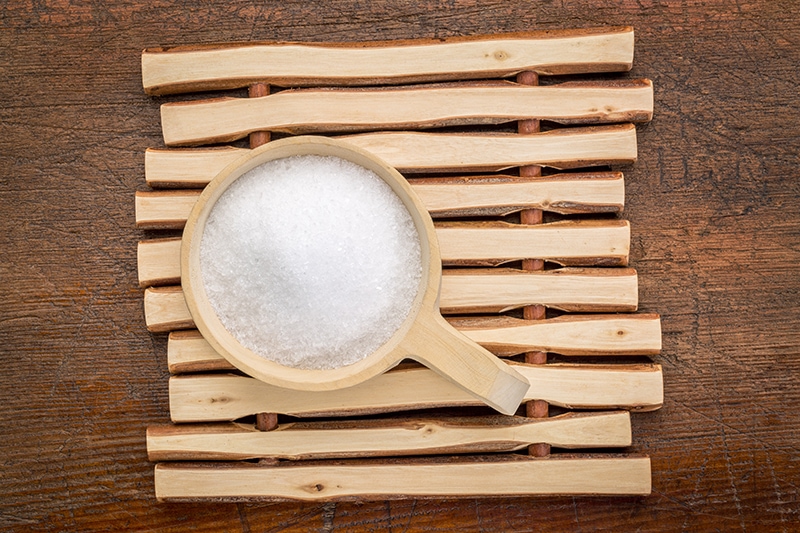Do Epsom Salt Baths Kill Fleas? Vet-Reviewed Safety Tips & Effectiveness

Updated on

Despite the name, Epsom salt doesn’t have much in common with the stuff on your table. Epsom salt is the common name for a chemical called magnesium sulfate. It’s often used in baths meant to relieve pain and as a mild antiseptic. But for your furry friends, Epsom salt is also reported to be a good flea killer. However, Epsom salts are not a recommended way to effectively treat fleas. Speak to your veterinary clinic about safe and effective prescription flea treatments and preventatives.
It is reported anecdotally that Epsom salts will dehydrate fleas and flea eggs, killing them. We could not find scientific reports to back up the use of Epsom salts in this way. If you are interested in a home-remedy flea solution, Epsom salt baths can be an alternative. This rundown will help you know how to treat your pet safely and whether it’s the right option for you.
Epsom Bath Pros and Cons

Epsom salt baths are considered as a natural way to help combat fleas by many people, but they do have their pros and cons. The biggest reason to avoid using Epsom salts for flea control is that it is less effective than commercial flea preparations. Epsom salt may be able to dehydrate fleas and eggs on your pet’s fur, but they can’t stop them hoping straight back on. That means if you choose an Epsom bath, you’ll need to redo it frequently while also killing fleas in your home environment. Remember that usually less than 5% of a flea life-cycle occurs on your pet and the rest of the problem is in their environment where the eggs and larvae are.
Most importantly they can also be dangerous if ingested, so it’s important to rinse your pet thoroughly. Another con of Epsom salts is that they can dry out your cat’s or dog’s skin. And, of course, many pets—especially cats—hate getting baths.
On the other hand, there are some possible reasons to use Epsom salts instead of commercial flea treatments. Epsom Salt baths work by dehydrating fleas, not poisoning them, so they don’t contain any pesticides which some people prefer to avoid. It may also be used as a stop gap treatment until you can get to the vet and pick up other products.
How to Give Your Cat or Dog an Epsom Bath
If you still want to give your cat or dog an Epsom salt bath, it’s important to do it right so that it is safe and effective. You’ll want to start by filling a basin of water with enough warm water to submerge your pet up to its back. The water should be warm to the touch but not uncomfortably hot. Then dissolve about ½ to 1 cup of Epsom salt into the bath for each gallon of water.
Let your pet soak in the Epsom water for 10–15 minutes. You can carefully wash around your pet’s head and neck but keep the treated water away from their eyes and mouth to avoid irritation. Do not let your pet drink the bathwater.
Once your pet has been soaking for long enough, drain the treated water and rinse your pet with clean, fresh water to remove any lingering salt. Finish by drying your pet with towels, a fan, or a blow dryer on cool.
- Make sure to expose your pet enough. You’ll want to let them soak for at least 10–15 minutes, and you should have about ½–1 cup of salt for every gallon of water. Too little Epsom salt will be ineffective.
- Don’t let your pet drink the salt water! Epsom salts are generally safe, but they can be harmful if ingested in large quantities. It’s also very important to rinse every bit of the Epsom salt from your cat’s fur as many cats will dry themselves by licking, ingesting any leftover salt in the process.
- Use Epsom salts in the rest of your home as well. In its dry form, Epsom salt can kill fleas in carpets, pet beds, wood floors, or furniture. Sprinkle the salt liberally over the surface and let it rest overnight. Then vacuum or wash the salt away, taking any dead fleas, larvae, and eggs with it. Keep your pets away from treated surfaces overnight.
- Repeat as necessary. Epsom salt baths may need frequent repeating to get rid of an infestation for good. So several baths over the course of a few weeks (along with cleaning the rest of your home) is important.
Last Thoughts
Epsom salt baths aren’t the most effective way to kill fleas, but they are an option to consider if traditional pest control is not what you want. Repeated baths and environment cleaning can boost their effectiveness to help you get your flea situation under control and help your cat or dog be happy and healthy again.
Featured Photo Credit: marekuliasz, Shutterstock










